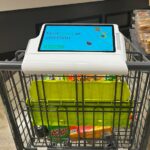
Instead of cutting out a paper coupon, wouldn’t it be so much easier if every store just let you show a bar code on your phone for a cashier to scan? It’s a fine idea – if there are systems in place to prevent fraud. Otherwise, as many retailers have learned the hard way, enterprising fraudsters could just grab a screenshot of a mobile coupon in order to share it, manipulate it, and use it again and again.
Mobile coupon providers have come up with a number of creative ways to fight this type of fraud. And now a technology company has come up with another creative idea it hopes will thwart the fraudsters.
Toshiba describes the idea in a newly-published patent application. The key element in its plan, is “noise.”
Not audible noise, but visual noise imperceptible to the naked eye, that will interfere with a coupon recipient’s ability to screenshot a working bar code.
Toshiba’s proposed system would generate a standard bar code encoded with all the information necessary for it to scan correctly. But then, the patent documentation explains, “the basic barcode is split into a plurality of images… in which noise is superimposed at different positions.” So one version of the bar code might have a blacked-out section on the left side, while another has a blacked-out section on the right. Individually, these bar codes are “undecodable,” but by “sequentially display(ing) the split barcode image group on a display device,” a scanner will be able to read it.
In other words, the system would generate multiple different versions of the same bar code, each of them partially blacked out (as seen in the example coupon image above, illustrating what some of the bar code components would look like, shown below what otherwise looks to be a standard bar code.) The system would rapidly switch among the images, so to your eye – and to a bar code scanner – it would look and work like a single, standard bar code. But if you try to take a screenshot, you’ll get a partially blacked-out bar code that’s unreadable by a scanner, and unusable.
The risk of customers grabbing and redeeming screenshots of legitimate coupons is one of the reasons mobile coupons haven’t been widely adopted just yet. Target learned the risks the hard way, when it tested out a precursor to what became its Target Circle loyalty program a few years ago. Many loyalty members who earned “perks” in the form of Target mobile coupons for free items, simply grabbed a screenshot, then shared and even sold them online. So shoppers who never actually earned a “perk” just displayed their screenshotted bar code on their phone, and got their freebie. Target ended up pulling the plug on the perks before formally unveiling Target Circle.
Toshiba’s system could have prevented all of that fraud from happening. So, too, could other systems proposed by other companies to make mobile bar codes more secure. The now-defunct company Mobeam once came up with a system that wouldn’t actually display a bar code on your phone at all – it would instead send beams of light arranged in a bar-code pattern to a scanner. So you’d never see a bar code, but the scanner would.
More recently, T-Mobile came up with a system in which a mobile coupon’s bar code would not appear on your phone’s screen until the phone detects that it’s being pointed at a scanner. Only then would the bar code appear, just long enough to be scanned, then it would disappear – before any fast-fingered screenshotter would be able to grab an image of it.
Still others, like The Coupon Bureau, are working to enable unique, serialized coupons that can only be used once. So even if you do grab a screenshot, you won’t be able to use it again if it’s already been redeemed.
So for anyone who’s been reluctant to issue mobile coupons for fear of fraud, Toshiba’s innovation, and those that have come before, are important steps in the right direction. Fraudsters who hastened the demise of Target’s earlier loyalty program have already ruined one retailer’s mobile coupon platform. Now Toshiba and others are trying to make sure that fraudsters don’t get a chance to do it again.
Image sources: Mobeam/Toshiba













